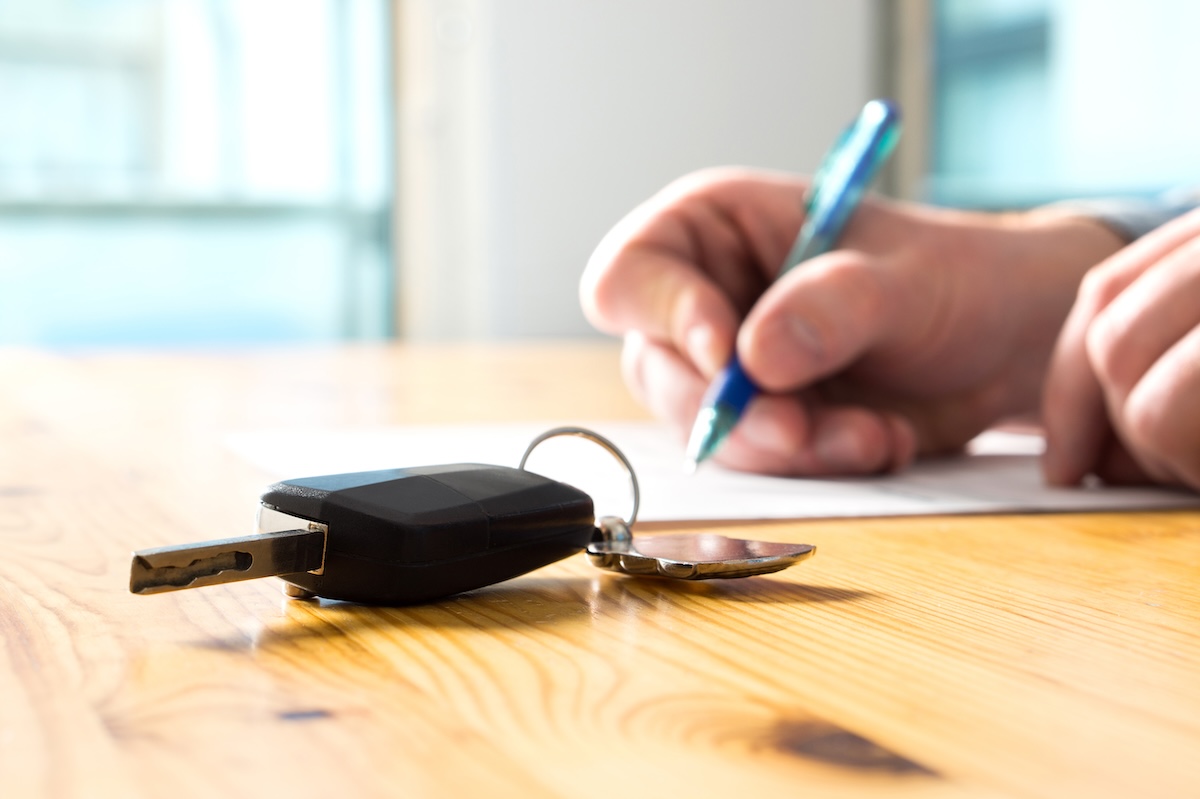When you're car shopping, you'll likely encounter various prices. However, the out-the-door purchase price is the comprehensive sum that covers everything you need to pay to drive the car off the dealer’s lot. It encompasses not just the base price of the vehicle but also all additional fees, taxes, and charges that may accompany the purchase.
Here’s what you need to know about what car dealerships often call an “out-the-door price.”
What’s an Out-The-Door Price on a New Car?
- Out-the-Door Price vs. MSRP: What’s the difference?
- How a Trade-In Impacts the Out-the-Door Price
- Factors in Calculating an Out-the-Door Price
- Why Knowing the Out-the-Door Cost Matters

Out-the-Door Price vs. MSRP: What’s the difference?
A federally mandated window sticker displays what is called the Manufacturer's Suggested Retail Price (MSRP) for new vehicles, but this figure doesn't tell the whole story. The MSRP typically includes only the cost of the vehicle itself, including any factory or port-installed options, as well as the destination or delivery charge. Be aware that the MSRP is not the invoice price, which is what the dealer pays the automaker to purchase the car before it even arrives in the showroom.
It’s worth focusing on the second word in the acronym MSRP: Suggested. Car manufacturers suggest what dealers should charge for a vehicle. A good negotiator may be able to get less than MSRP, while a high-demand vehicle might command more than MSRP.
In contrast, the out-the-door price provides the total cost by incorporating all associated costs, such as taxes, registration fees, and dealership charges. It is the car dealer’s bottom line.
How a Trade-In Impacts the Out-the-Door Price
Trading in your current vehicle can significantly affect the out-the-door price calculation. If you owe more on your trade-in than its appraised value, the negative equity is added to your new car loan. Consequently, this increases the overall amount you will pay. On the other hand, if you have positive equity in your trade-in, it can offset the cost of the new car. In some cases, this may also reduce your tax liability.
Factors in Calculating an Out-the-Door Price
Several components contribute to the total amount:
- Taxes and government charges: Sales taxes cannot be negotiated. They may be levied at various levels – state, county, or city – and they vary greatly across the country. For example, Nevada and California have the highest auto sales tax rates, while five states (Alaska, Delaware, Montana, New Hampshire and Oregon) don’t charge any car tax. In most cases, you will be taxed based on where you live, not where you buy the car. Title fees and doc fees also cannot be negotiated. Fees will be higher for new cars than for used cars.
Title and registration fees needed to drive the car legally are also mandatory.
Not all dealerships will be able to collect taxes and other government charges, but they can likely provide you with a solid estimate of what they will cost based on where you plan to register the vehicle as well as the selling price of the vehicle.
- Dealer Fees: Dealerships may charge additional fees such as preparation, advertising, additional profit, destination charges and documentation fees. Sometimes these are negotiable, though many dealers will insist on adding them.
Always read the small print in an ad or the paperwork when going through with a new-car purchase. Ask your salesperson, “What other fees do you add on to the price of the car?” and make sure they list them all.
-
Financing Fees: If you are financing your new car, the loan principal, interest charges, gap insurance, and extended warranty and any origination fees are included in the out-the-door price. Any increase in interest rate or addition of fees will increase the overall price of the car through the entire loan term. Dealers may try to hide those increases by lengthening the loan term, making your payments appear lower. Do not let that practice make you feel like you are paying less. Lenders have different fees so when in doubt, read the fine print. Remember that your credit score will have an impact on your financing, but arriving at the dealership with a preapproval buts the dealer in a position of needing to provide you with a more favorable auto loan to earn your business.
-
Rebates: Manufacturer rebates or incentives can help reduce the out-the-door cost, so it is essential to consider these when calculating your final price. Some rebates are provided directly to the buyer and will decrease the total price of the vehicle. Manufacturers can also offer the dealers incentives for specific models, typically when they know they have too many of a particular model in stock.
Manufacturer-to-dealer rebates don’t have to be disclosed to a buyer and may, or may not, be passed along to a customer.
- Down Payment: A higher down payment can lower your out-the-door price by reducing your loan amount and interest charges. That said, a higher down payment uses your money and does not lower the price of the car, but rather the amount being financed or the final check. Don’t forget to add it back in when thinking about your budget.

Why Knowing the Out-the-Door Cost Matters
Understanding the out-the-door price is crucial for several reasons:
-
Budgeting: Considering all associated costs is a key factor in determining if a vehicle fits within your budget. A car that is affordable can become too expensive if the cost of registering and paying taxes on the car is not accounted for. Taxes alone can approach 10 percent in some areas.
-
Comparison: Comparing out-the-door prices allows you to make informed decisions between different car options and dealerships. Many buyers narrow down which car to purchase to a particular model and trim level.
The out-the-door price lets the buyer see the extra fees one dealer might charge compared to another. If one is more than the other, it simply means that one of the dealers has added more fees or isn’t offering as big of a discount.
-
Monthly Payment Fallacy: Focusing solely on monthly payments can be deceptive, as dealerships may manipulate them without offering true savings. Dealers can change a monthly payment by simply extending the length of the loan. This allows them to stretch any fees across more months, which your car payments appear lower even though the final out-the-door price will still be the same. There are price calculators available online that will provide an accurate estimate of your payments and car price before you walk in the dealer’s door.
-
Negotiating Power: An out-the-door price will enable you to easily see price discounts, additional fees, and other items that can change the price of the car more easily. Armed with the full picture gives you the power to negotiate a better price when car buying.



